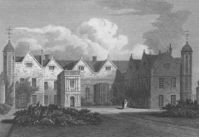- Charlecote Park
-
Charlecote Park stately home Charlecote ParkCountry England Region Midlands District Warwickshire Municipality Warwick Founded Built c.16th century Owner in the care of the National Trust Visitation accessible to the public with a fee (All year round) Website: *Charlecote Park information at the National Trust Charlecote Park (grid reference SP263564) is a grand 16th century country house, surrounded by its own deer park, on the banks of the River Avon in Wellesbourne, about 4 miles (6 km) east of Stratford-upon-Avon and 5.5 miles (9 km) south of Warwick, Warwickshire, England. It has been administered by the National Trust since 1946 and is open to the public. It is a Grade I listed building
The Lucy family, who came to England with William the Conqueror, has owned the land since 1247. Charlecote Park was built in 1558 by Sir Thomas Lucy, and Queen Elizabeth I stayed in the room that is now the drawing room. Although the general outline of the Elizabethan house remains, nowadays it is in fact mostly Victorian. Successive generations of the Lucy family had modified Charlecote Park over the centuries, but in 1823, George Hammond Lucy (High Sheriff of Warwickshire in 1831) inherited the house and set about recreating the house in its original style.
In the middle of the 19th century the Fairfax Baronets inherited the property when the male line of the Lucy family failed on the death of Henry Spencer Lucy. The baronets changed their family name to Lucy to reflect the traditions of Charlecote.
The Great Hall has a barrel-vaulted ceiling made of plaster painted to look like timber and is a fine setting for the splendid collection of family portraits. Other rooms have richly coloured wallpaper, decorated plaster ceilings and wood panelling. There are magnificent pieces of furniture and fine works of art, including a contemporary painting of Queen Elizabeth I. The original two-storey Elizabethan gatehouse that guards the approach to the house remains unaltered.
Charlecote Park covers 185 acres (75 ha), backing on to the River Avon. William Shakespeare has been alleged to have poached rabbits and deer in the park as a young man and been brought before magistrates as a result.[1] But it is unclear whether there were any deer in the park at that time. It was landscaped by Capability Brown in about 1760.
In the Tudor great hall, the 1680 painting Charlecote Park by Sir Godfrey Kneller, is said to be one of the earliest depictions of a black presence in the West Midlands. The painting, of Captain Thomas Lucy, shows a black boy in the background dressed in a blue livery coat and red stockings and wearing a gleaming, metal collar around his neck. The National Trust's Charlecote brochure describes the boy as a "black page boy". In 1735 a black child called Philip Lucy was baptised at Charlecote.[2]
On display at the house is an original letter from Oliver Cromwell, dated 1654, summoning then owner Richard Lucy to the Barebone's Parliament. Also on display is a 1760 portrait of George Lucy by Thomas Gainsborough which cost Lucy the sum of eight guineas.[3]
A set of archives for the Lucy family at Charlecote is held by the National Archive[4] The house also has a display of carriages and a period laundry and brewroom.
Notes
- ^ Terry A. Gray, The Lost Years, Palomar College.
- ^ The Guardian
- ^ Malan, A. H., (1899) "Famous Homes of Great Britain and Their Stories"
- ^ LUCY OF CHARLECOTE at nationalarchives.gov.uk
Bibliography
- History of the Commoners of Great Britain and Ireland, Volume 3 (1835) John Burke. Lucy of Charlecote pp 97–101. (ISBN 9781847271686)
- English Heritage: Images of England, architectural description of listed building
External links
- Charlecote Park information at the National Trust
- Photos of Charlecote Park and surrounding area on geograph
- Charlecote Park Photos and Information
Coordinates: 52°12′19″N 1°37′00″W / 52.20520°N 1.61657°W
The Fairfax family First generation Second generation Third generation Thomas Fairfax, 3rd Lord Fairfax of Cameron • Henry Fairfax, 4th Lord Fairfax of Cameron • Henry FairfaxFourth generation Thomas Fairfax, 5th Lord Fairfax of CameronFifth generation Sixth generation Seventh generation Thomas Fairfax, 9th Lord Fairfax of Cameron • Ferdinando FairfaxNinth generation Tenth generation Eleventh generation Twelfth generation Fairfax family residences: Ash Grove • Belvoir • Charlecote Park • Denton Hall • Gilling Castle • Greenway Court • Lee-Longsworth House • Leeds Castle • Leesylvania • Mount Eagle • Nunappleton • Oak Hill • Towlston Grange • Vaucluse Categories:- Fairfax family residences
- Country houses in Warwickshire
- National Trust properties in Warwickshire
- Grade I listed buildings in Warwickshire
- Grade I listed houses
- Historic house museums in Warwickshire
- Gardens in Warwickshire
Wikimedia Foundation. 2010.




